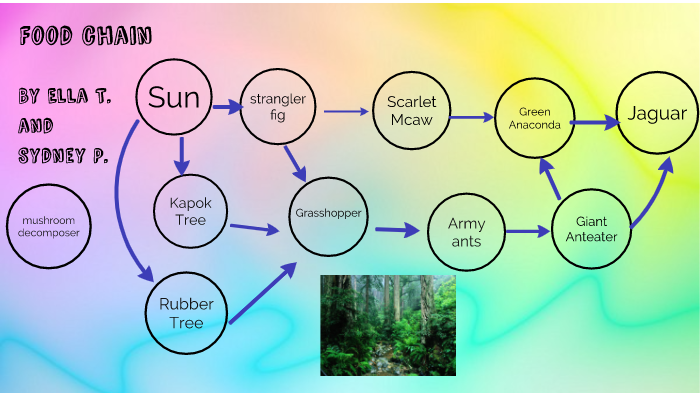
Its s also on the top of the food-chain in Peru and nearby countries in South America. The extremely muscular anaconda is a constrictor and has teeth and powerful jaws that it utilizes to clench onto its prey.
The grasshoppers energy then goes to the squirrel then the squirrel to a snake and a.
Green anaconda food chain. Food chains are a simple way to show how every animal eats one another to survive. There are four important things that make up a food chain. The producer is always a plant getting their energy from the sun.
The consumer is always a herbivore. A rabbit or a mouse. Anacondas food chain.
Published with reusable license by aliya burr. Food webs are like food chains except more complicated for the energy of one animal can go to other animals too. A plant is eaten by a possum a squirrel and a grasshopper.
The grasshoppers energy then goes to the squirrel then the squirrel to a snake and a. Green anacondas can grow to more than 29 feet weigh more than 550 pounds and measure more than 12 inches in diameter. Females are significantly larger than males.
Other anaconda species all. The extremely muscular anaconda is a constrictor and has teeth and powerful jaws that it utilizes to clench onto its prey. It grabs its victim and pulls it underwater drowning the prey.
They typically feed on large rodents tapirs capybaras deer peccaries fish turtles birds sheep dogs and aquatic reptiles. Habitat of the Green Anaconda. The most common habitats for these reptiles are rivers meandering through tropical rainforest.
They are native to streams rivers river basins wetlands marshes and swamps. The vast majority of their time is spent in the water mainly because they are capable of much easier movement while swimming. They can go without food for 6 months after having a large meal.
It is amazing how long green anacondas can survive without food. In fact the trick is in the portion of the food they eat. They eat big portions such as entire deer capybara or jaguar and they digest them slowly during a long stretch of time.
Green anaconda are not venomous. The green anacondas transplantation in the Everglades has severely disrupted the ecosystems food chain and the green anacondas introduction to the area will be a challenge for the ecosystem to overcome. Green anacondas feed on large rodents deer fish peccaries capybaras tapirs turtles birds dogs sheep aquatic reptiles like caiman and even jaguars.
After asphyxiating their prey they are able to unhinge their jaws to swallow their prey head-first and whole regardless of size. With this being said among the most popular scholastic facts is that anaconda snakes are the largest mammalian predator in the Arizonas. Its s also on the top of the food-chain in Peru and nearby countries in South America.
Along the lips of the anacondas theyve sensing pits. Like all other ecosystems the food chains in the Amazon have 5 different components. Primary producers These are the organisms that produce the source of food for the community.
Producers are usually green plants and are essential for the survival of the community. Green anacondas are apex predators meaning that they are at the top of their food chain according to ADW. Sometimes however going after large animals like.
The anacondas belong to apex predators which means they are at the top of their food chain. After their big meal they can be satisfied for weeks digesting that what has been eaten. With the life span up to 10 years in wildness and up to even 30 years in captivity the anaconda snakes come to sexual maturity when they are about 4 years old.
The Yellow Anacondas are a dirty yellow color with black splotches along its back and is much smaller than the Green Anaconda only gaining 80 pounds. The Yellow Anaconda is shorter in length reaching about 15 feet. Nonetheless both Anacondas are aggressive predators that dominate the food chain.
How Did The Anaconda Find Florida. Producer - A producer in ecology is an autotrophic organism typically a photosynthetic green plant that synthesizes organic matter from inorganic materials. This organism is usually in the early stage of a food chain.
Consumer- Consumers are organisms of an ecological food chain that receive energy by consuming other organisms. The common food chain of a Harpy Eagle consists of a tertiary consumer being the Harpy Eagle a primary consumer being the Pygmy Sloth two secondary consumers the Squirrel Monkey and Cappuccino Monkey a single primary producer the Cecropia Tree and two detrivores meaning they eat decaying or dead matter Earth Worms and Termites.
